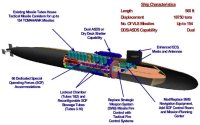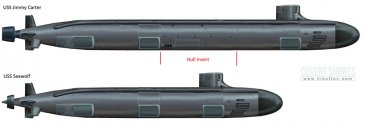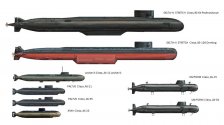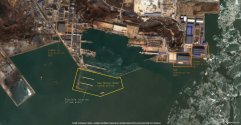Developing an SSGN ab initio is one thing but if you've got SSBN with plenty of pressure hull and reactor life left and for whatever reason (arms control treaty, better SSBN design) you no longer need them as SSBN, then makes sense to convert them to SSGN or spec ops or whatever. So I can see at least some 094s being re-rolled once sufficient 096s are in service to carry out the deterrent role.
Three remarks:
1. SSGN are a Soviet invention in response to unique Soviet needs.
They were initially designed as
strategic land attack vessels due to limitations of ballistic missile technology and used the cumbersome P-5 Pyatyorka missile that required the sub to surface for 30 minutes for launch. There were also 16 convetional Juliett with four P-5 missiles built from 1960 as interim measure due to delays with Echo but they were abandoned as soon as nuclear propulsion became reliable.
When R-27 SLBM became available Soviet navy ordered Yankee-class SSBNs but the concept of nuclear-armed cruise missiles to combat US carrier groups was retained and
SSGNs became anti-carrier submarines armed with specialized anti-ship missiles.
- 5x Echo I (1958) - 6x P-5 (450km)
- 29x Echo II (1961) - 8x P-6 (500km), later 14 converted to 8x P-500 (550km)
- 1x Papa (1963) - 12x P-70 (60km)
- 11x Charlie I (1964) - 8x P-70 (60km)
- 6x Charlie II (1974) - 8x P-120 (70km)
- 2x Oscar I (1975) - 24 P-700
- 6x Oscar II (1982) - 24x P-700
- total: 60 SSGNs
US never acquired SSGNs and only installed TLAM (Tomahawk Land Attack Missile) launchers in Los Angeles Flight II after 31 boats of Flight I were built. 8 Flight II and 23 Flight III (688i) boats were built each with 12 TLAM VLS in the bow section. The first 688 with VLS was ordered
in 1979. By the end of the Cold War 31 VLS subs were built but all of them had
tactical land attack function.
Virginia with VPM is not really an SSGN as it is a natural evolution of submarine warfare, similarly to what Yasen represents.
2. Ohio-style SSGN conversion is not effective in military terms but only in economic terms.
Ohio conversion was initially decided in 1994 and refit was done 2002 to 2008 at the cost of
700 million USD per boat (FY08). At the time the calculus of VLS tubes made it seem economical because Virginia had no modular launcher capacity and the cost of continuing service of 4 Ohio subs would bring financial benefit to the industry. Nuclear propulsion is an expensive and specialized field with low economies of scale and
between 1992 and 2000 USN reduced half of its nuclear fleet.
in service:
- 18x Ohio SSBN (1 reactor)
- 62x Los Angeles SSN (1 reactor)
- 2x Seawolf SSN (1 reactor)
- 1x Enterprise CVN (8 reactors)
- 8x Nimitz CVN (2 reactors) + 2 more after 2000
- total: 91 hulls / 106 reactors
retired:
- 10x James Madison SSBN (1 reactor)
- 12x Benjamin Franklin SSBN (1 reactor)
- 13x Permit SSN (1 reactor)
- 36x Sturgeon SSN (1 reactor) + remaining 1 boat in 2005
- 4x Virginia CGN (2 reactors)
- 2x California CGN (2 reactors)
- 1x Truxtun CGN (2 reactors)
- 1x Long Beach CGN (2 reactors)
- total: 79 hulls / 87 reactors
Always ensure that you have complete context because information out of context loses meaning.
Converted Ohio SSGN loses half of the volume of the missile compartment (Trident II - 13,6m x 2,1m vs Tomahawk - 6,5m x 0,5m). Ohio SSGNs were also a combined SSGN/Spec-Ops submarine able to carry both 154 TLAMs and up to 66 additional personnel housed in the refitted missile compartment. All those assets are placed in a single vessel that could be eliminated in a single anti-submarine operation but most importantly because of the "economy" refit and lack of technology for modular payloads Ohio SSGNs simply aren't flexible enough and can fulfill only that dual role - thus making it just an oversized Los Angeles/Virginia.

For special purposes other submarines were used, notably the third Seawolf-class boat "Jimmy Carter" - note the length of hull added.

Ohio SSGNs make sense only in the context of a unique geopolitical situation of the time and are tools of colonial warfare and not a viable asset in a peer conflict. People who refuse to do the necessary thinking simply accept everything that exists at face value not realizing how much grift and graft is inherent in all military procurement, particularly once the military industrial complex is firmly established and has to undergo reductions.
3. SSBN to special purpose submarine conversion is effective in both military and economic terms.
There is a whole array of functions that a refitted SSBN can fill and Russia provides an excellent example of that. This is a graphic from HI Sutton's 2018 article. RussianShips.info lists two additional small submarines and "Belgorod" which is replacing "Orenburg".

It appears that Northern Fleet operates two large carrier submarines converted from SSBNs which act as moterships for smaller submarines or "nuclear-powered deep-diving stations" in Russian nomenclature. The conversion was extensive - both Delta SSBNs had their hump removed which indicates that an entire section was replaced - a much greater degree of intervention than the "cheap" Ohio conversion.
This is what Sutton suggests Belgorod may look like inside:

Considering that Belgorod was orginally an Oscar class with two parallel inner hulls it makes sense that a SLBM section would be the minimum required for similar functionality.
Type 09IV is comparatively a small SSBN being ~20m shorter and displacing less than Delta III/IV and closer to Delta I/II and Benjamin Franklin classes. It could however be stretched during conversion, like "Jimmy Carter", particularly if instead of crewed mini-subs drones are used to greater extent.
The only question is level of noise that is acceptable for certain missions however considering that neither Delta III nor Delta IV are "quiet" submarines and they're being used regardless of constant persence of USN submarines in the Arctic.
As for the utility of such vessels - anything that has application in the Arctic will have
greater application in the Pacific. The distances and depths are greater so underwater/seabed infrastructure plays a much greater role. Considering that China's interests in the future will extend to the Arctic as well I would see a minimum of four special carrier submarines to field two ready vessels - one for North Pacific/Arctic and one for South Pacific. Any such operations in Indian and Atlantic ocean are probably an issue for farther future.
Ohio SSBNs were laid down in:
- 1976 - 1
- 1977 - 1
- 1979 - 1
- 1981 - 3
- 1983 - 2
- 1986 - 2
- 1987 - 3
- 1988 - 1
- 1990 - 1
- 1991 - 1
- 1992 - 1
Boats 1-4 (1976-81) took 5 years to make, boats 5-8 (1981-83) took 3 years and boats 9-10 (1986-87) took only 2 years. The remaining boats were built at slower pace of 4 to 6 years. The point I'm making is that once mass production is prepared and implemented after the first few boats it is achievable to build the necessary 12 SSBNs within approximately a decade. This means that Type 09VI could take much less time than usually is assumed and thus Type 09IV could become available at earlier date for conversion as it is not a very useful deterrence asset with 09VI/JL-3 in place. So the conversions might happen as soon as mid 2030s which would put the first two - from 2007 and 2009 - at 25 years of service.
However - what do we know about the lifecycle of the reactor and its economic feasibilty? What if it is designed to serve for 25 years only? Perhaps Type 09IV is designed with planned obsolescence in mind and can be written off without loss after 25 years? The other 4 (or more) boats will be at 10 or 20 years so it might be economic to refit them for special missions. And so If I was to speculate I'd assume a fast production cycle of 12 Type 09VI between 2025-2035 and conversion of 412, 414, 420 and 421 to special mission at the end and after that period.
Type 09IVA is valuable now but will not be a viable asset in 2035 much like first 18 to 23 (out of 34 built!) Yankee-class SSBNs were scrapped before 1991, despite being a leap in capabilities over Hotel SSBN with just 3 SLBMs - which were also scarapped at the same time (1987-1991). Deterrence must be viable and the factors that play into viability don't follow logic of service life-cycles.







